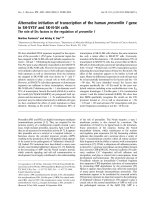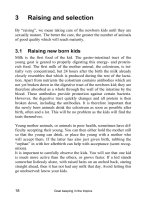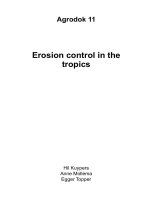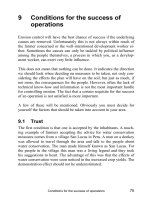Treatment of Osteoarthritic Change in the Hip - part 1 pps
Bạn đang xem bản rút gọn của tài liệu. Xem và tải ngay bản đầy đủ của tài liệu tại đây (489.96 KB, 26 trang )
M. Sofue, N. Endo (Eds.)
Treatment of Osteoarthritic Change in the Hip
Joint Preservation or Joint Replacement?
M. Sofue, N. Endo (Eds.)
Treatment of
Osteoarthritic
Change in the Hip
Joint Preservation or
Joint Replacement?
With 198 Figures, Including 12 in Color
Muroto Sofue, M.D.
Director of Nakajo Central Hospital
Chairman of the Orthopaedic Division
12-1 Nishihon-cho, Tainai, Niigata 959-2656, Japan
Naoto Endo, M.D.
Professor and Chairman
Division of Orthopedic Surgery
Niigata University Graduate School of Medical and Dental Sciences
1-757 Asahimachi-dori, Niigata 951-8510, Japan
Library of Congress Control Number: 2006938396
ISBN-10 4-431-38198-8 Springer Tokyo Berlin Heidelberg New York
ISBN-13 978-4-431-38198-3 Springer Tokyo Berlin Heidelberg New York
This work is subject to copyright. All rights are reserved, whether the whole or part of the material
is concerned, specifically the rights of translation, reprinting, reuse of illustrations, recitation, broad-
casting, reproduction on microfilms or in other ways, and storage in data banks.
The use of registered names, trademarks, etc. in this publication does not imply, even in the absence
of a specific statement, that such names are exempt from the relevant protective laws and regulations
and therefore free for general use.
Product liability: The publisher can give no guarantee for information about drug dosage and applica-
tion thereof contained in this book. In every individual case the respective user must check its
accuracy by consulting other pharmaceutical literature.
Springer is a part of Springer Science+Business Media
springer.com
© Springer 2007
Printed in Japan
Typesetting: SNP Best-set Typesetter Ltd., Hong Kong
Printing and binding: Shinano, Japan
Printed on acid-free paper
Preface
V
The 32nd Japanese Hip Society (JHS) Congress was held November 6–8, 2005, in
Niigata, Japan. Guest speakers from many countries and specialists for hip disease
presented papers that focused on joint preservation for osteoarthritis of the hip, joint
preservation for aseptic necrosis of the femoral head, treatment for epiphyseolysis
capitis femoris, and up-to-date information and knowledge on joint arthroplasty.
Altogether, there were many important presentations about joint preservation and
replacement. This book covers the main themes of the congress.
The starting point for the treatment of hip disease depends on how we can preserve
the natural hip joint and on steps leading to regeneration of the diseased, injured, or
destroyed joint. Preservation and regeneration treatments following traditional and
theoretical methods do not need to use expensive materials, such as the artificial
joints used in arthroplasty. On the other hand, preservation and regeneration treat-
ments are difficult to perform and require a lengthy rehabilitation period.
Recently, too much attention has been paid to these demerits, resulting in a yearly
decrease in the number of cases receiving joint-preserving treatment. This move away
from traditional methods denies the surgeon the experience and knowledge of the
benefits associated with the most biologically appropriate treatment. As the president
of JHS and a hip surgeon, I believe there is a need to halt this tendency, to promote
the benefits of histological treatment, and to allow the young surgeon insight into
joint-preservation surgery. Also, as a hip surgeon I am not neglecting joint replace-
ment as a treatment for hip disease. I, myself, perform total hip arthroplasty for
patients with severely damaged hip joints and those who have no other therapeutic
choice than joint-replacement surgery.
As an editor of this book, I am very hopeful that readers gain insight into the proper
treatment of hip disease.
Muroto Sofue
President of the 32nd Japanese Hip Society
Contents
Preface . . . . . . . . . . . . . . . . . . . . . . . . . . . . . . . . . . . . . . . . . . . . . . . . . . . . . . . . . . . . . V
List of Contributors . . . . . . . . . . . . . . . . . . . . . . . . . . . . . . . . . . . . . . . . . . . . . . . . . . XI
Part I: Slipped Capital Femoral Epiphysis (SCFE)
Retrospective Evaluation of Surgical Treatments for Slipped Capital
Femoral Epiphysis
H. Fujii, T. Otani, S. Hayashi, Y. Kawaguchi, H. Tamegai, M. Saito,
N. Tanabe, and K. Marumo . . . . . . . . . . . . . . . . . . . . . . . . . . . . . . . . . . . . . . . 3
Treatment of Slipped Capital Femoral Epiphysis
M. Katano, N. Takahira, S. Takasaki, K. Uchiyama,
and M. Itoman. . . . . . . . . . . . . . . . . . . . . . . . . . . . . . . . . . . . . . . . . . . . . . . . . . . . 9
Indications for Simple Varus Intertrochanteric Osteotomy for the
Treatment of Osteonecrosis of the Femoral Head
H. Ito, T. Hirayama, H. Tanino, T. Matsuno, and A. Minami . . . . . . . . 19
Transtrochanteric Rotational Osteotomy for Severe Slipped Capital
Femoral Epiphysis
S. Nagoya, M. Kaya, M. Sasaki, H. Kuwabara, T. Iwasaki,
and T. Yamashita . . . . . . . . . . . . . . . . . . . . . . . . . . . . . . . . . . . . . . . . . . . . . . . . 27
Corrective Osteotomy with an Original Plate for Moderate Slipped Capital
Femoral Epiphysis
T. Kitakoji, H. Kitoh, M. Katoh, T. Hattori, and N. Ishiguro . . . . . . 33
Follow-up Study After Corrective Imhäuser Intertrochanteric Osteotomy for
Slipped Capital Femoral Epiphysis
S. Mitani, H. Endo, T. Kuroda, and K. Asaumi . . . . . . . . . . . . . . . . . . . . . 39
VII
VIII Contents
Slipping of the Femoral Capital Epiphysis: Long-Term Follow-up
Results of Cases Treated with Imhaeuser’s Therapeutic Principle
M. Sofue and N. Endo . . . . . . . . . . . . . . . . . . . . . . . . . . . . . . . . . . . . . . . . . . . . 47
In Situ Pinning for Slipped Capital Femoral Epiphysis
S. Iida and Y. Shinada . . . . . . . . . . . . . . . . . . . . . . . . . . . . . . . . . . . . . . . . . . . . 61
Retrospective Evaluation of Slipped Capital Femoral Epiphysis
M. Ko, K. Ito, K. Sano, N. Miyagawa, K. Yamamoto,
and Y. Katori . . . . . . . . . . . . . . . . . . . . . . . . . . . . . . . . . . . . . . . . . . . . . . . . . . . . 69
Part II: Avascular Necrosis of the Femoral Head
Osteotomy for Osteonecrosis of the Femoral Head: Knowledge
from Our Long-Term Treatment Experience at Kyushu University
S. Jingushi . . . . . . . . . . . . . . . . . . . . . . . . . . . . . . . . . . . . . . . . . . . . . . . . . . . . . . . 79
Joint Preservation of Severe Osteonecrosis of the Femoral
Head Treated by Posterior Rotational Osteotomy in Young Patients:
More Than 3 Years of Follow-up and Its Remodeling
T. Atsumi, Y. Hiranuma, S. Tamaoki, K. Nakamura, Y. Asakura,
R. Nakanishi, E. Katoh, M. Watanabe, and T. Kajiwara . . . . . . . . . . . 89
Limitations of Joint-Preserving Treatment for Osteonecrosis
of the Femoral Head: Limitation of Free Vascularized Fibular Grafting
K. Kawate, T. Ohmura, N. Hiyoshi, T. Teranishi, H. Kataoka,
K. Tamai, T. Ueha, and Y. Takakura . . . . . . . . . . . . . . . . . . . . . . . . . . . . . . 97
Treatment of Large Osteonecrotic Lesions of the Femoral Head:
Comparison of Vascularized Fibular Grafts with Nonvascularized
Fibular Grafts
S Y. Kim . . . . . . . . . . . . . . . . . . . . . . . . . . . . . . . . . . . . . . . . . . . . . . . . . . . . . . . . . 105
A Modified Transtrochanteric Rotational Osteotomy for Osteonecrosis of
the Femoral Head
T.R. Yoon, S.G. Cho, J.H. Lee, and S.H. Kwon . . . . . . . . . . . . . . . . . . . . . . . 117
Vascularized Iliac Bone Graft Using Deep Circumflex Iliac Vessels
for Idiopathic Osteonecrosis of the Femoral Head
K. Tokunaga, M. Sofue, Y. Dohmae, K. Watanabe, M. Ishizaka,
Y. Ohkawa, T. Iga, and N. Endo . . . . . . . . . . . . . . . . . . . . . . . . . . . . . . . . . . . 125
Contents IX
Part III: Osteoarthritis of the Hip: Joint Preservation or
Joint Replacement?
Joint-Preserving and Joint-Replacing Procedures: Why, When, and Which?
A Challenging and Responsible Decision
S. Weller . . . . . . . . . . . . . . . . . . . . . . . . . . . . . . . . . . . . . . . . . . . . . . . . . . . . . . . . 137
Twenty Years of Experience with the Bernese Periacetabular Osteotomy
for Residual Acetabular Dysplasia
R. Ganz and M. Leunig . . . . . . . . . . . . . . . . . . . . . . . . . . . . . . . . . . . . . . . . . . . 147
Joint Reconstruction Without Replacement Arthroplasty for Advanced-
and Terminal-Stage Osteoarthritis of the Hip in Middle-Aged Patients
M. Itoman, N. Takahira, K. Uchiyama, and S. Takasaki . . . . . . . . . . . . 163
Part IV: Total Hip Arthroplasty: Special Cases and Techniques
Minimally Invasive Hip Replacement: Separating Fact from Fiction
C.F. Young and R.B. Bourne . . . . . . . . . . . . . . . . . . . . . . . . . . . . . . . . . . . . . . . 183
Hip Resurfacing: Indications, Results, and Prevention of Complications
H.C. Amstutz, M.J. Le Duff, and F.J. Dorey . . . . . . . . . . . . . . . . . . . . . . . . 195
Current Trends in Total Hip Arthroplasty in Europe and Experiences
with the Bicontact Hip System
H. Kiefer . . . . . . . . . . . . . . . . . . . . . . . . . . . . . . . . . . . . . . . . . . . . . . . . . . . . . . . . 205
Crowe Type IV Developmental Hip Dysplasia: Treatment with Total Hip
Arthroplasty. Surgical Technique and 25-Year Follow-up Study
L. Kerboull, M. Hamadouche, and M. Kerboull . . . . . . . . . . . . . . . . . . . 211
Total Hip Arthroplasty for High Congenital Dislocation of the Hip:
Report of Cases Treated with New Techniques
M. Sofue and N. Endo . . . . . . . . . . . . . . . . . . . . . . . . . . . . . . . . . . . . . . . . . . . . 221
A Biomechanical and Clinical Review: The Dall–Miles Cable System
D.M. Dall . . . . . . . . . . . . . . . . . . . . . . . . . . . . . . . . . . . . . . . . . . . . . . . . . . . . . . . 239
Index . . . . . . . . . . . . . . . . . . . . . . . . . . . . . . . . . . . . . . . . . . . . . . . . . . . . . . . . . . . . . . 251
XI
List of Contributors
Amstutz, H.C. 195
Asakura, Y. 89
Asaumi, K. 39
Atsumi, T. 89
Bourne, R.B. 183
Cho, S.G. 117
Dall, D.M. 239
Dohmae, Y. 125
Dorey, F.J. 195
Endo, H. 39
Endo, N. 47, 125, 221
Fujii, H. 3
Ganz, R. 147
Hamadouche, M. 211
Hattori, T. 33
Hayashi, S. 3
Hiranuma, Y. 89
Hirayama, T. 19
Hiyoshi, N. 97
Iga, T. 125
Iida, S. 61
Ishiguro, N. 33
Ishizaka, M. 125
Ito, H. 19
Ito, K. 69
Itoman, M. 9, 163
Iwasaki, T. 27
Jingushi, S. 79
Kajiwara, T. 89
Katano, M. 9
Kataoka, H. 97
Katoh, E. 89
Katoh, M. 33
Katori, Y. 69
Kawaguchi, Y. 3
Kawate, K. 97
Kaya, M. 27
Kerboull, L. 211
Kerboull, M. 211
Kiefer, H. 205
Kim, S Y. 105
Kitakoji, T. 33
Kitoh, H. 33
Ko, M. 69
Kuroda, T. 39
Kuwabara, H. 27
Kwon, S.H. 117
Le Duff, M.J. 195
Lee, J.H. 117
Leunig, M. 147
Marumo, K. 3
Matsuno, T. 19
Minami, A. 19
Mitani, S. 39
Miyagawa, N. 69
Nagoya, S. 27
Nakamura, K. 89
Nakanishi, R. 89
Ohkawa, Y. 125
Ohmura, T. 97
Otani, T. 3
Saito, M. 3
Sano, K. 69
Sasaki, M. 27
Shinada, Y. 61
Sofue, M. 47, 125, 221
Takahira, N. 9, 163
Takakura, Y. 97
Takasaki, S. 9, 163
Tamai, K. 97
Tamaoki, S. 89
Tamegai, H. 3
Tanabe, N. 3
Tanino, H. 19
Teranishi, T. 97
Tokunaga, K. 125
Uchiyama, K. 9, 163
Ueha, T. 97
Watanabe, K. 125
Watanabe, M. 89
Weller, S. 137
Yamamoto, K. 69
Yamashita, T. 27
Yoon, T.R. 117
Young, C.F. 183
XII List of Contributors
Part I
Slipped Capital Femoral
Epiphysis (SCFE)
Retrospective Evaluation of Surgical
Treatments for Slipped Capital
Femoral Epiphysis
Hideki Fujii, Takuya Otani, Seijin Hayashi,
Yasuhiko Kawaguchi, Hideaki Tamegai, Mitsuru Saito,
Nobutaka Tanabe, and Keishi Marumo
Summary. The summary of our treatment strategy for SCFE is presented. Acute/
unstable SCFE in which epiphyseal mobility is observed under fluoroscopy is treated
by manual reduction as early as possible, followed by internal fixation with two
screws. Chronic/stable SCFE with posterior tilt angle (PTA) less than 40° is treated by
in situ single-screw fixation with the dynamic method. For those with PTA of 40° and
more, it is important to comprehend the pathology using a CT scan for accuracy, and
intertrochanteric flexion osteotomy seems to be one of the simplest and most predict-
able treatment modalities.
Key words. Slipped capital femoral epiphysis, Stable type, Unstable type, Manual
reduction, Chondrolysis
Introduction
We report the outcomes of surgical treatments for slipped capital femoral epiphysis
(SCFE) at our department. The treatment strategies for various types of SCFE are
reviewed.
Materials and Methods
Our review includes 26 cases, 28 hips, with SCFE that were treated at our university
hospital and affiliated hospitals. There were 19 male and 7 female patients. Age at
onset ranged from 5 to 31 years, with an average of 12.7 years. The average follow-up
period was 3 years and 7 months. Onset modes included 2 hips of acute type, 8 hips
of acute on chronic type, and 18 hips of chronic type.
As for treatment method, 10 unstable SCFE that consisted of acute type and acute
on chronic type were treated by manipulative reduction followed by internal fixation.
Eleven stable/chronic SCFE with posterior tilt angle (PTA) 40° and less were treated
3
Department of Orthopedic Surgery, The Jikei University School of Medicine, 3-25-8 Nishi-
Shinbashi, Minato-ku, Tokyo 105-8461, Japan
4 H. Fujii et al.
by in situ fixation. Among the hips of chronic type with PTA more than 40°, 6 were
treated by trochanteric osteotomy and 1 by subcapital femoral neck osteotomy.
The evaluated items were as follows. Preoperatively, PTA was measured on Lau-
renstein X-ray to determine the degree of slippage. We examined MRI for two cases
to check contralateral hip for preslip evidence to discuss the need for preventive fixa-
tion [1]. Postoperatively, PTA was measured for assessment. Hip function was assessed
using Japanese Orthopaedic Association (JOA) hip score and range of motion. Post-
operative complications such as femoral necrosis and chondrolysis were also
examined.
Results
The average PTA for ten acute/unstable type hips that were treated by manipulative
reduction was 51° before reduction and 22° after. There was no case of femoral necro-
sis, but chondrolysis was observed in one hip. Preoperative PTA was 70° for this case,
and narrowing of joint space was observed within a year after the surgery, which was
considered to be attributable to chondrolysis. After 2 years postoperative, however,
radiographic joint space was improved. At postoperative 4 years and 7 months
(Fig. 1), the clinical outcome was good, although some formation of osteophytes was
observed [2].
The outcomes for 18 hips of chronic/stable type included that the average postop-
erative PTA for 11 hips after in situ fixation was 31°. For 7 hips that were treated by
osteotomy, preoperative PTA was 51° and postoperative PTA was 25°. There were no
complications for the chronic/stable type group.
The PTA measured at the last follow-up was found to be improved by 7° on average
for this series of cases when compared with immediate postoperative angle. This
Fig. 1. Case 1. An 11-year-old girl (at time of
operation). At 4 years and 7 months after
operation, the joint space was improved
Surgical Treatment for SCFE 5
Fig. 2. Case 2. An 11-year-old girl. a Posterior tilt angle (PTA) (at time of the injury): 70°.
b PTA (after reduction): 18° (contralateral PTA, 9°). Note that only the acute portion of the
slippage was reduced, and overreduction was avoided
change was considered to be an effect of remodeling, as was reported by Bellemans
et al. [3].
Clinical results at the last follow-up were generally good. There were no complaints
of hip pain. The average Japanese Orthopedic Association (JOA) hip score was 98.
Good range of motion was confirmed for flexion, abduction, and external rotation,
whereas mild restriction was observed for internal rotation.
Discussion
After reviewing these results as well as the literature, our current treatment strategy
has been determined as follows.
Theory and Indication of Manipulative Reduction
The case that is classified as acute/acute on chronic type, clinically classified as un-
stable type by Loder et al. [4], and is observed to demonstrate obvious mobility at
the separated epiphysis under fluoroscopy, should be manually reduced as early as
possible, and then internally fixed with two screws (Fig. 2a,b).
The manual reduction technique that we use for the hip with physeal instability is
not a forceful manipulation, but rather a quiet and gradual flexion, abduction, and
ab
6 H. Fujii et al.
internal rotation of the joint to find a good position of the leg under fluoroscopy [2,5].
Also, it is important to reduce only the acute portion of the slippage and not to
overreduce [6].
Morphological improvement gained by manual reduction would lead to functional
improvement of the hip and lower the risk of arthritis in the future. Although the
possibility is undeniable that blood circulation in the femoral head may be compro-
mised, the opposite possibility does exist, that is to say, manual reduction could
improve blood circulation, as indicated by Kita et al. [7]. Taking these considerations
into account, we believe our treatment policy is well justified. Both Peterson et al. [8]
and Gordon et al. [9] reported that the improvement of blood flow in the vessels
supplying nutrients in the epiphysis that was provided by anatomical reduction
prevented necrosis of the femoral head. Their reports recommended early reduction
for unstable SCFE, which was proved by good clinical results.
Dynamic Single-Screw Fixation
Chronic/stable type slippage with PTA less than 40° is treated by in situ fixation. In
the past, we used multiple devices for internal fixation; however, we have been using
single-screw fixation recently, which is reported to have a lower complication rate
than fixation with multiple screws [5]. We also have tried the dynamic method,
reported by Kumm et al. in 1996, in which a screw is inserted to protrude from the
lateral cortex to prevent premature physeal closure [10].
A 5-year-old girl and a 12-year-old boy were treated with this dynamic method and
are presently being followed (Fig. 3). For the former patient, several screw replace-
ments are anticipated before physeal closure occurs.
Fig. 3. Case 3. A 12-year old boy with PTA (at
injury) 35°. Dynamic single-screw fixation was
used
Surgical Treatment for SCFE 7
a
c
b
Osteotomy
Chronic/stable type with PTA of 40° and more has been treated by trochanteric and
subcapital osteotomy. We employed the Southwick procedure in the past for the
chronic/stable type with PTA of 40° to 70°. This procedure is relatively technically
demanding, yet does not always seem to be successful in achieving the intended
correction. Thus, we are now trying to understand the pathology using computed
tomography (CT) scan for accuracy, and also to consider simple flexion osteotomy,
depending on the situation (Fig. 4) [11].
Fig. 4. Case 4. A recent case, not included
in this evaluation. a Preoperative. b Post-
operative. c Three-dimensional computer
simulation
8 H. Fujii et al.
References
1. Lalaji A, Umans H, Schneider R, et al (2001) MRI features of confirmed “pre-slip”
capital femoral epiphysis: a report of two cases. Skeletal Radiol 31:362–365
2. Otani T, Suzuki H, Kato A, et al (2004) Clinical results of closed manipulative reduc-
tion for acute-unstable slipped capital femoral epiphysis. Seikeigeka 55:771–777
3. Bellemans J, Farby G, Molenaers G, et al (1996) Slipped capital femoral epiphysis: a
long-term follow-up, with special emphasis on the capacities for remodeling. J Pediatr
Orthop (B) 5:151–157
4. Loder RT, et al (1993) Acute slipped capital femoral epiphysis: the importance of
physeal stability. J Bone Joint Surg 75A:1134–1140
5. Aronsson DD, Lorder RT, et al (1996) Treatment of the unstable (acute) slipped capital
femoral epiphysis. Clin Orthop Relat Res 322:99–110
6. Casey BH, Hamilton HW, Bobechko WP (1972) Reduction of acutely slipped upper
femoral epiphysis. J Bone Joint Surg 54B:607–614
7. Kita A, Morito N, Maeda S, et al (1995) Indication and procedure of manual reduction
and subcapital osteotomy for slipped capital femoral epiphysis. Seikei-Saigaigeka
38:631–638
8. Peterson MD, Weiner DS, Green NE, et al (1997) Acute slipped capital femoral epiphy-
sis: the value and safety of urgent manipulative reduction. J Pediatr Orthop 17:
648–654
9. Gordon JE, Abrahams MS, Dobbs MB, et al (2002) Early reduction, arthrotomy, and
cannulated screw fixation in unstable slipped capital femoral epiphysis treatment. J
Pediatr Orthop 22:352–358
10. Kumm DA, Lee SH, Hackenbroch MH, et al (2001) Slipped capital femoral epiphysis:
a prospective study of dynamic screw fixation. Clin Orthop Relat Res 384:198–207
11. Kamegaya M, Saisu T, Ochiai N, et al (2005) Preoperative assessment for intertrochan-
teric femoral osteotomies in severe chronic slipped capital femoral epiphysis using
computed tomography. J Pediatr Orthop B 14:71–78
9
Treatment of Slipped Capital
Femoral Epiphysis
Motoaki Katano, Naonobu Takahira, Sumitaka Takasaki,
Katsufumi Uchiyama, and Moritoshi Itoman
Summary. Slipped capital femoral epiphysis (SCFE) is a comparatively rare disorder
with various new treatment modalities. Twenty-nine hips (27 patients) in this study
were treated (1971–2004). Mean age was 12.5 years, and mean follow-up period was
54.7 months. Among unilateral SCFE patients, there were 7 acute, 6 acute on chronic,
and 16 chronic SCFE. Average posterior tilting angle (PTA) on admission was 47.6°.
Pinning was performed on 11, osteotomy on 9, and in situ pinning on 9 hips. Unaf-
fected-side prophylactic fixation was performed on 13 hips (44.8%). Postoperative
complications of avascular necrosis of the femoral head were noted in 7 hips (24.1%).
Femoral head deformity was noted in 3 hips (10.3%). For acute SCFE, we perform
gentle reduction by traction and epiphysiodesis. For chronic slips, we perform
epiphysiodesis or osteotomy. Opinions remain divided concerning unaffected-side
prophylactic fixation; however, we consider observation sufficient. The postoperative
complication rate was higher in acute slips. Femoral head avascular necrosis is caused
by failure of the remaining capital nutrient vessels. Anatomical reduction of the
epiphysis is necessary. Therefore, prophylaxis is indispensable to prevent avascular
necrosis. In future reports, we will include many more cases with these procedures,
focusing on improved results and patient benefits.
Key words. Slipped capital femoral epiphysis, Epiphysiodesis, Prophylaxis, In situ
pinning, Osteotomy
Introduction
Slipped capital femoral epiphysis (SCFE) is a comparatively rare disorder; however,
various new methods for its treatment have been reported. The various treatments
offer methods for gentle reduction by traction, manual reduction, internal fixation,
and osteotomy. For a slight slip, we perform epiphysiodesis such as in situ pinning.
For a moderate slip, we perform an osteotomy and open reduction. We have investi-
gated clinical and radiographic evaluation of the patients suffering from SCFE who
have undergone surgical therapy in our hospital.
Department of Orthopaedic Surgery, Kitasato University School of Medicine, 1-15-1 Kitasato,
Sagamihara, Kanagawa 228-8555, Japan
10 M. Katano et al.
Materials and Methods
There were 27 patients (23 males, 4 females) in the present study, with 29 hips treated
surgically from 1971 to 2004 in the Kitasato University Hospital. Patient age ranged
from 7 to 20 (mean, 12.5) years old. The follow-up period was 9 to 99 (mean, 54.7)
months. There were no preslips; however, there were 2 cases of bilateral SCFE. Among
the patients with unilateral SCFE, there were 7 acute, 6 acute on chronic, and 16
chronic SCFE. The average posterior tilting angle (PTA) on admission was 47.6°. The
underlying disease was Down syndrome; hypothyroidism was seen in 1 hip, eunuch-
oidism and Frohlich’s syndrome were seen in 1 hip, and juvenile rheumatoid arthritis
(JRA) with short-stature chronic renal failure was seen in 1 hip.
Clinical evaluations of treatment methods, prophylactic fixation of the unaffected
side, rehabilitation, complications, and radiographic evaluation of the PTA were
investigated.
Results
Of the surgically treated cases, pinning (cannulated screw fixation) was performed on
11 hips, osteotomy on 9 hips, and in situ pinning on 9 hips. According to the classifica-
tion of severity, pinning was performed on 6 hips and osteotomy was performed on 1
hip of an acute slip. Pinning was performed on 1 hip, osteotomy on 6 hips, and in situ
pinning on 9 hips of chronic slips. Pinning was performed on 4 hips and osteotomy
was performed on 2 hips in acute on chronic slips (Table 1). Prophylactic fixation of
the unaffected side was performed on 13 hips (44.8%), and there was deformity of the
femoral head in 1 hip and a femoral neck fracture after removal of the nail in 1 hip.
For rehabilitation, partial weight-bearing started after 6 weeks, and brace support for
non-weight-bearing was applied in 6 cases. Postoperative complications of avascular
necrosis of the femoral head were noted in 7 hips (24.1%). Joint space narrowing and
deformity of the femoral head were also noted in 3 hips (10.3%) (Table 2). According
to the classification, the acute type of SCFE was seen in 4 of 7 hips (57.1%), acute on
chronic type in 2 of 6 hips (33.3%), and the chronic type in 4 of 16 hips (25%). The
Table 1. Clinical classification and treatment methods
Type of slip Pinning Osteotomy In situ pinning
(ARO, VFO)
Acute 61 0
Chronic 16 9
Acute on chronic 42 0
Total 11 9 9
ARO, anterior rotational osteotomy; VFO, valgus flexion osteotomy
Table 2. Complications
Complication Males Females Number (%)
Infection 000
Avascular necrosis of 617 (24.1%)
femoral head
Osteolysis 000
Deformity of femoral head 123 (10.3%)
Treatment of Slipped Capital Femoral Epiphysis 11
surgical methods included pinning in 6 of 11 hips (54.5%), osteotomy in 4 of 9 hips
(44.4%), and in situ pinning in 0 of 9 hips. Additional operations using bone grafts
were performed for avascular necrosis of the femoral head in 2 hips. The average PTA
at the time of the injury was 47.6° (20°–85°), and the average postoperative PTA was
17.9° (0°–40°). The average PTA after pin removal at the final follow-up was 15.9°
(0°–31°) (Table 3).
Case 1
A 12-year-old boy suffered from acute SCFE with a PTA of 65° that was reduced to
22° by skeletal traction for 2 weeks. We performed epiphysiodesis by a cancellous
bone screw in this position. It was removed 6 months postoperatively. Neither defor-
mity of the femoral head nor necrosis was found in the final follow-up period, and
he had an excellent postoperative course (Fig. 1).
Table 3. Posterior tilting angle (PTA)
Type of slip Admission Postoperative Final follow-up
Acute 54.4° 16.1° 16.5°
(33°–85°) (0°–40°) (8°–20°)
Chronic 41.8° 20.5° 16°
(20°–80°) (0°–35°) (0°–31°)
Acute on chronic 54.8° 13° 14.7°
(30°–65°) (0°–30°) (14°–15°)
Total 47.6° 17.9° 15.9°
(20°–85°) (0°–40°) (0°–31°)
ab
c
Fig. 1. Case 1. Acute slipped capital femoral epiphysis (SCFE) in a 12-year-old boy with poste-
rior tilting angle (PTA) of 65° on admission (a). We performed epiphysiodesis with cannulated
screw fixation, PTA was 20° (b). At 6 months after epiphysiodesis, the cancellous bone screw
was removed with excellent results (c)
12 M. Katano et al.
a
b
Case 2
A 13-year-old boy suffered from chronic SCFE with a PTA of 78°. We performed an
anterior rotational osteotomy (ARO) of the femoral head using an F-system device.
The postoperative PTA was 32°. The patient started partial weight-bearing 6 weeks
after the operation. We removed the device 2.5 years postoperatively. A limitation
of internal rotation was seen 4 years postoperatively; however, X-rays and clinical
examination findings were excellent during the course (Fig. 2).
Fig. 2. Case 2. Chronic SCFE in a 13-year-old boy with PTA of 78° (a). After anterior rotational
osteotomy (ARO) of the femoral head using an F-system device, PTA was 32° (b). The device
was removed 2.5 years postoperatively (c). Limitation of internal rotation was seen 4 years
postoperatively (d)
Treatment of Slipped Capital Femoral Epiphysis 13
Case 3
A 13-year-old boy suffered from acute SCFE with a PTA of 85°. We performed epi-
physiodesis with cannulated screw fixation because the slip had been reduced by
skeletal traction for 10 days. We feared the development of avascular necrosis of the
femoral head; therefore, we applied a non-weight-bearing brace and observed the
patient’s condition. However, we observed flattening of the lateral femoral head after
8 months. We removed the screws 2 years postoperatively and performed strut
allograft bone grafting. Twenty years later, the patient was able to walk without pain
but had developed a femoral head deformity (Fig. 3).
cd
Fig. 2. Continued
14 M. Katano et al.
ab
c
d
e
Fig. 3. Case 3. Acute SCFE in a 13-year-old boy with PTA of 85° (a). We performed epiphysio-
desis with cannulated screw fixation, PTA was 18° (b). We observed flattening of the lateral
femoral head (c). We removed the screws 2 years postoperatively and performed strut allograft
bone grafting (d). At follow-up at 20 years, he could walk without pain but had developed a
femoral head deformity (e)
Treatment of Slipped Capital Femoral Epiphysis 15
Discussion
For treatment, epiphysiodesis such as in situ pinning was performed for a slight slip
of less than 30°. For a more than moderate slip, in situ pinning, rotational Sugioka
osteotomy, three-dimensional Southwick osteotomy, Imhauser osteotomy, or a sub-
capital osteotomy was performed [1–3].
The strategy of treatment for SCFE in our institution for acute or acute on chronic
SCFE is to reduce the slip slowly by skeletal traction. After reduction and stabilization,
we perform epiphysiodesis by pinning. We do not perform invasive manipulative
reduction because that could lead to avascular necrosis of the femoral head. For
chronic SCFE, we perform in situ pinning or an osteotomy, depending on the degree
of slip. When the preoperative PTA is less than 30° in slip, we perform epiphysiodesis
by in situ pinning. When the PTA is 30° to 50°, or moderate slip, we perform a valgus
flexion osteotomy, and when the PTA is more than 50° in slip, we perform ARO
(Fig. 4) [4].
Regarding prophylactic fixation of the unaffected side, Hotokebuchi and Sugioka
[5] and Kato et al. [6] reported that prophylactic nailing is not necessary in the
absence of a basal disease such as an endocrine disease, in which case observation
alone is sufficient. In addition, Iga et al. [7] showed that unaffected-side fixation
should be performed for all cases regardless of the amount of slip, whether acute or
chronic. Kita et al. [8] performed internal fixation for prevention for the unaffected
side when the affected side was highly suspected of avascular necrosis, or when there
was a patient they could not observe sufficiently, or if the patient was suffering from
remarkable obesity or endocrinopathy. Castro et al. [9] reported that the risk of iat-
rogenic chondrolysis and avascular necrosis might outweigh the benefits of prophy-
lactic pinning of the contralateral hip. We have always considered bilateral slip a high
risk and have been concerned about the contralateral side of the slip. Therefore, we
have performed prophylactic fixation of the unaffected side for all patients since 1985.
However, there are not many cases of bilateral slips. Therefore, we have recently
changed our strategy to do a cross follow-up with a prophylactic fixation.
As reported by Itoman [4] and Sofue et al. [1], the incidence factors of avascular
necrosis of the femoral head involve acute slip, manual reduction, capital osteotomy,
Acute
Acute on chronic
Chronic type
Gentle reduction by
skeletal traction
In situ pinning
(epiphysiodesis)
Pinning
(epiphysiodesis)
Trochantic
osteotomy
(VFO)
Trochantic
osteotomy
(ARO)
30
o
< PTA <50
o
50
o
< PTAPTA 30
o
Fig. 4. Strategy of our treatment for SCFE. VFO, valgus flexion osteotomy; ARO, anterior rota-
tional osteotomy; PTA, posterior tilting angle
16 M. Katano et al.
and open reduction. Reduction could be problematical in that it could damage a
nutrient vessel of the femoral head during the procedure or lead to reslipping;
however, even manual reduction under general anesthesia is not necessarily a pro-
phylaxis for this risk. Kita et al. [8] reported that it is extremely important to imme-
diately reduce dislocation of unstable persistent nutrient vessels as a prophylactic
measure. Manual repositioning may be chosen for cases of femoral head mobility.
Otani et al. [10] reported that the necessity of manual reduction is relevant to pro-
phylaxis, which is done to remove pressure and torsion of the epiphyseal nutrient
vessels by performing anatomical reduction of the epiphysis in the unstable type of
SCFE. In Kitasato University Hospital, avascular necrosis of the femoral head as a
postoperative complication was noted in seven hips (24.1%). Even though gentle
skeletal traction and fixation were performed to avoid the invasiveness of manual
reduction, there was high risk of avascular necrosis of the femoral head. We conjec-
tured that a nutrient vessel to the femoral head had already been damaged before the
patient arrived at the hospital. Considering this type of prophylaxis, it may be benefi -
cial to the evaluation to do a cross follow-up using magnetic resonance imaging
(MRI), although we did not perform an MRI. If necrosis occurs, we apply a long leg
brace and perform a bone graft to reestablish the blood supply, and it is naturally
important to prevent a collapse of the femoral head.
Conclusion
For acute SCFE, we perform gentle reduction by traction and epiphysiodesis. For
chronic slips, we perform epiphysiodesis or osteotomy. Opinions remain divided
concerning prophylactic fixation of the unaffected side; however, we consider ob-
servation sufficient. The postoperative complication rate was higher in acute slips.
Avascular necrosis of the femoral head is caused by failure of the remaining capital
nutrient vessels. It is necessary to perform anatomical reduction of the epiphysis.
Therefore, prophylaxis is indispensable to prevent avascular necrosis. In future
reports, we will include many more cases with these procedures focusing on improved
results and patient benefits.
References
1. Sofue M, Hatakeyama S, Endo N, et al (2005) Imhauser’s three-dimensional osteotomy
for slipped capital femoral epiphysis. J Joint Surg 24:762–768
2. Southwick WO (1967) Osteotomy through the lesser trochanter for slipped capital
femoral epiphysis. J Bone Joint Surg [Am] 49:807–835
3. Sugioka Y, Eguchi M, Kaibara N, et al (1976) Transtrochanteric anterior rotation
osteotomy of the femoral head for idiopathic avascular necrosis in adults. Hip Joint
2:23–32
4. Itoman M (1989) Epiphysiodesis for slipped capital femoral epiphysis. J Joint Surg
8:1637–1644
5. Hotokebuchi T, Sugioka Y (1995) Anterior rotational osteotomy for slipped capital
femoral epiphysis. Orthop Surg Traumatol 38:639–644
6. Kato Y, Sato M, Umemura M (2002) The study of prophylactic pinning of the contra-
lateral hip in slipped capital femoral epiphysis. Orthop Surg 53:512–516









